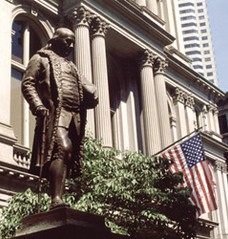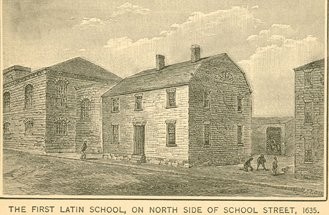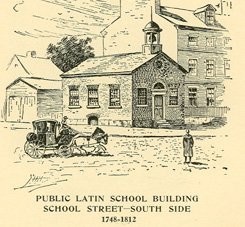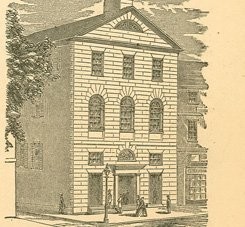Benjamin Franklin Statue & Boston Latin School
Introduction
Text-to-speech Audio
Images
The Benjamin Franklin Statue which represents the original site of the Boston Latin School, the first public school in the country.

The first Boston Latin School, on the North side of School Street, 1635. Although the postcard says 1635, it is likely that this is the building that was constructed about 10 years later.

The second Boston Latin School, on the South side of School Street, which sat on this location from 1745-1812.

The third and final Boston Latin School to sit on this site, from 1812-1922.

Backstory and Context
Text-to-speech Audio
Established in 1635 in the home of headmaster Philemon Pormont, Boston Latin School became the first public school in America. It began as a post-secondary school that prepared young boys for college. The school was modeled after the Free Grammar School of Boston, England. Latin and Greek were taught to the pupils, and emphasis was placed on the study of humanities. It opened its doors on this site in 1645, when the first schoolhouse was constructed. For the previous ten years, the school had operated out of the home of Philemon Pormont (an early Puritan settler), whose house was located near the spot where Causeway Street and the Charleston Bridge meet today. James Otis published a book in 1910 entitled “Ruth of Boston.” In part of the book (a link is included below and the section about Master Pormont’s school begins on page 112), early life in the Massachusetts Bay Colony under the instruction of Headmaster Philemon Portmont was described.
The first three schoolhouses were located on South Street. The first building was a small schoolhouse on the North side of the street. This building was demolished one hundred years later (1745) to make way for the expansion of King’s Chapel. The Boston Latin School moved across the street. In 1812, the school was reconstructed and stayed there until 1922, when it moved to its current location in the Back Bay.
Some of the Boston Latin School’s most well-known alumni include five of the signers of the Declaration of Independence: John Hancock, Samuel Adams, Robert Treat Paine, William Hooper and Benjamin Franklin. On the front lawn of the Old City Hall, there is a statue of Benjamin Franklin. The monument marks the spot of the original schoolhouse. It is interesting that Franklin was chosen to mark the site, since although he was definitely one of the most significant figures in American history to have attended the school, he never graduated from it. Franklin dropped out of Boston Latin School after just two years because his family could now longer afford to p ay the cost of tuition. He later moved to Philadelphia, where he spent most of his adult life.
The Boston Latin School is still a fully functioning public school, with students enrolled in grades 7-12. However, it has changed with time, becoming coeducational in 1972 and moving locations several times. In 1922, the school moved to its current home in Boston’s Fenway neighborhood. Admission to Boston Latin is very competitive and is limited to residents of the city.
Sources
Site of Boston Latin School. Boston Literary District. Accessed April 14, 2018. http://bostonlitdistrict.org/venue/site-boston-latin-school/.
Benjamin Franklin Statue & Boston Latin School. The Freedom Trail Foundation. Accessed April 15, 2018. http://www.thefreedomtrail.org/freedom-trail/benjamin-franklin-statue.shtml.
Otis, James. Ruth of Boston: A Story of the Massachusetts Bay Colony. Google Books. Accessed April 15, 2018. https://books.google.com/books?id=aw4XAAAAYAAJ&pg=PA112&lpg=PA112&dq=philemon+pormont&source=bl&ots=.... Originally published 1910.
